ABOUT
The Happy and Beautiful Hummingbirds
The images on this website were collected on hummingbirds coming to the feeders on the rail of a balcony in Southern California. Under the balcony, there is a small shrub. Beyond the balcony and the shrub, and within close proximity, an area of dense vegetation. This is where hummingbirds call home year-round. The bird population during winter time differ from year to year judging by the amount of sugar water the birds consume. However, the birds are noticeably absent between about March to May. During that time, wild flowers outside of the City boundary is in full bloom. The birds waste no time chasing after the blooming flowers.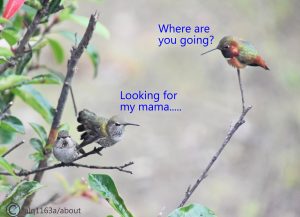
Through serendipitous circumstances (see II. Introducing Bella), the nearly daily photographic documentation of the visiting birds started a few years ago, and evolved. These images, taken from a single location, inevitably capture the daily lives of the birds, i. e. their coming and going, behaviors, rituals, and interactions between each other and in a group. The subject matter turned out to be incredibly rich and interesting. The collective images demonstrate surprising unknown aspects of the birds, and that they are complex far beyond their shear exterior beauty.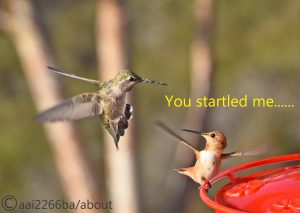
Hummingbird is known as the smallest bird species. It is also known to have one of the highest flying speed. The reported speed varies, on average 30 mph up to 60 mph. Such high speed for such a tiny bird zooming in front our eyes gives us the physical sense of “a split second”. Because of the combination of size and speed, coupled with the bird’s jittery nature, the subtleties of the birds’ behaviors easily elude human observations. Excellent videos in internet have captured their elegant flying forms. However, the still images serve a different purpose and provide information that is otherwise missing in the videos. The still images reveal the details of the birds’ behaviors in their natural habitats, and show how they communicate with each other via their expressive eyes, countless body languages and a sequence of funny actions to accomplish a task, and all within a matter of seconds.
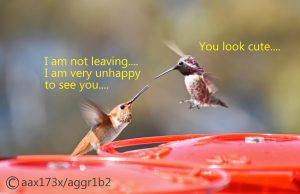
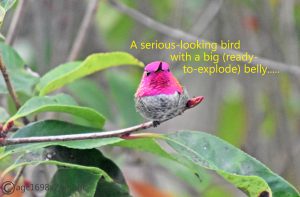 There are many surprising findings. For example, these images suggest that the birds identify with their own (“look-alike”) species, particularly as twins. They fly, eat and perch together, and they share food. The images also suggest empathetic instinct by imitating the behaviors of the neighboring bird(s). In that, their beaks and bodies would line up in parallel as a group and eyes looking at the same direction. When the birds are face-to-face, in fight or kissing, the two long beaks would almost always form a nearly perfect straight line. The images show this behavior serves social, defensive and offensive functions. Images also show that hovering can be negotiating to join the feeder, sometimes allowed and sometimes rejected. A bird with the head up, chest and big belly out looking all regal and important is a signal to other birds that “this seat is mine, I am not leaving”. The birds have effective common language (funny posturing) to deter enemies, avoid a fight and physical harm. The majority of the birds are peaceful and actively seek other birds’, particularly twin’s, company, not deserving the aggressive and solitary reputation. These are happy birds coming to the feeders and the shrub every day to eat, dance, nap, play, socialize, fight, snuggle…..living a daily life. They are adorable, goofy, brave, comical, persistent, smart, sometimes naughty with a big attitude, or even as an occasional vicious warrior. As the tiniest bird in the world, they thrive in this vast universe.
There are many surprising findings. For example, these images suggest that the birds identify with their own (“look-alike”) species, particularly as twins. They fly, eat and perch together, and they share food. The images also suggest empathetic instinct by imitating the behaviors of the neighboring bird(s). In that, their beaks and bodies would line up in parallel as a group and eyes looking at the same direction. When the birds are face-to-face, in fight or kissing, the two long beaks would almost always form a nearly perfect straight line. The images show this behavior serves social, defensive and offensive functions. Images also show that hovering can be negotiating to join the feeder, sometimes allowed and sometimes rejected. A bird with the head up, chest and big belly out looking all regal and important is a signal to other birds that “this seat is mine, I am not leaving”. The birds have effective common language (funny posturing) to deter enemies, avoid a fight and physical harm. The majority of the birds are peaceful and actively seek other birds’, particularly twin’s, company, not deserving the aggressive and solitary reputation. These are happy birds coming to the feeders and the shrub every day to eat, dance, nap, play, socialize, fight, snuggle…..living a daily life. They are adorable, goofy, brave, comical, persistent, smart, sometimes naughty with a big attitude, or even as an occasional vicious warrior. As the tiniest bird in the world, they thrive in this vast universe.
While these images, and the patterns of these images, may advance our understandings on these bird s, the interpretation of these images on this website is entirely subjective. The use of the descriptive words such as “pack behavior”, “twins”, “love birds”…etc. represents subjective opinions, not meant for scientific accuracy. Further, this website has made no attempt to identify the species, nor the gender, nor the maturity level of the bird. Instead, the color, e.g. “orange”, “redhead”, “white belly”, or “baby bird”, or other physical attributes are used as an approximation. This is in part due to the difficulty in the precise identification, as well as the lack of consensus on the physical characteristics, let alone the behavioral characteristics, attributing to a particular species, among more than 350 known species. For example, no clear consensus on how to identify a common orange-feather bird, a Rufous or an Allen’s? And they do come in many different forms. Readers are encouraged to decipher these images and write their own captions and conclusions.
s, the interpretation of these images on this website is entirely subjective. The use of the descriptive words such as “pack behavior”, “twins”, “love birds”…etc. represents subjective opinions, not meant for scientific accuracy. Further, this website has made no attempt to identify the species, nor the gender, nor the maturity level of the bird. Instead, the color, e.g. “orange”, “redhead”, “white belly”, or “baby bird”, or other physical attributes are used as an approximation. This is in part due to the difficulty in the precise identification, as well as the lack of consensus on the physical characteristics, let alone the behavioral characteristics, attributing to a particular species, among more than 350 known species. For example, no clear consensus on how to identify a common orange-feather bird, a Rufous or an Allen’s? And they do come in many different forms. Readers are encouraged to decipher these images and write their own captions and conclusions.
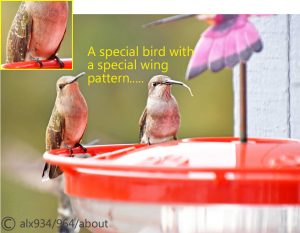 Over the years, there are sightings of unusual birds, not only by their physical appearance, but also by their behaviors. They differ dramatically, from a “Zen” bird that would not move one muscle nor one feather even on feeders with 20+ birds buzzing around, or with a camera literally on its face (“total Zen”), to a jittery bird that would fly away even with the slightest movement inside the closed sliding doors, perhaps sensing the gravity field shift? Indeed these birds can tell a story of their own. The bird on the left of the two white-belly birds is unusual, not only with an unusual body shape and light yellow smooth belly, it also has an unusual pattern on its wings. This bird is a protector of the white belly on the right, with its tongue sticking out. They hanged together for over 30 minutes, an eternity for two love birds.
Over the years, there are sightings of unusual birds, not only by their physical appearance, but also by their behaviors. They differ dramatically, from a “Zen” bird that would not move one muscle nor one feather even on feeders with 20+ birds buzzing around, or with a camera literally on its face (“total Zen”), to a jittery bird that would fly away even with the slightest movement inside the closed sliding doors, perhaps sensing the gravity field shift? Indeed these birds can tell a story of their own. The bird on the left of the two white-belly birds is unusual, not only with an unusual body shape and light yellow smooth belly, it also has an unusual pattern on its wings. This bird is a protector of the white belly on the right, with its tongue sticking out. They hanged together for over 30 minutes, an eternity for two love birds.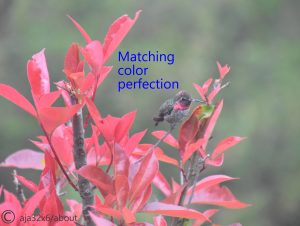
The shrub under the balcony turns out to be a favorite home for the birds. Even though the home has hundreds of “rooms” (branches and leaves), all birds only perch on a handful of branches. What are their criteria of choice? The birds come to shrub to hang out, snuggle, fight, nap, and dance in the rain…. making the shrub a social gathering place, particularly busy during dinner time. Shrub grows new leaves, sheds old leaves, leaves change colors, branches get trimmed by the gardener…..but it always provides a beautiful backdrop, even matching colors, to enhance the beauty of the birds.
None of the images have been published elsewhere until this website. The images tell the stories of the daily life of hummingbirds. The first three stories are: “Pack and Synchronous Behaviors”, “Introducing Bella”, and “Twins Forever”. Future stories include, e.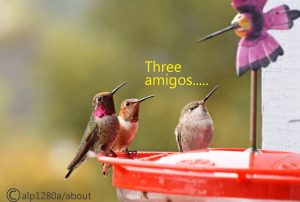 g., “Greeting, the Hummingbird Way”, “Lovebirds…Share, Kiss, Snuggle and PDA”, “Aggression, Hummingbird Style”, “Hover, How to Annoy Other Birds”, “The Incorrigible Bullies” ….and more. The “Daily Extra” are images not entirely organized. There is a Section on Videos and Slideshows where the sequence of actions demonstrates that the actions are not random, but communicative and with a purpose. New stories, new images under the published stories will be added on an irregular basis.
g., “Greeting, the Hummingbird Way”, “Lovebirds…Share, Kiss, Snuggle and PDA”, “Aggression, Hummingbird Style”, “Hover, How to Annoy Other Birds”, “The Incorrigible Bullies” ….and more. The “Daily Extra” are images not entirely organized. There is a Section on Videos and Slideshows where the sequence of actions demonstrates that the actions are not random, but communicative and with a purpose. New stories, new images under the published stories will be added on an irregular basis.
These images were taken with a hand-held Nikon D5500 (earlier D5200) and a Tamron 16-300mm Macro lens, mostly at the Sport mode of 5 frames per second. The only light source was the natural light. The images on birds on shrub were taken through the patio glass windbreaker at a downward angle. Adobe Photoshop was used on some images to auto adjust contrast, adjust brightness and lighten shadows, no color or background corrections, or other corrections were applied.
Despite our effort to understand these intriguing creatures, they will always remain beyond our total reach and always mysterious and enchanting. In the meantime, enjoy these beautiful creatures, and let these images inspire your imaginations.
